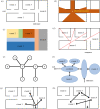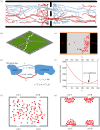The principles of pedestrian route choice
- PMID: 35382581
- PMCID: PMC8984324
- DOI: 10.1098/rsif.2022.0061
The principles of pedestrian route choice
Abstract
Pedestrian route choice, the process by which individuals decide on their walking path between two locations, is a fundamental problem across disciplines. Because this behaviour is investigated from different conceptual and methodological angles, and because it strongly depends on the environmental context, it is challenging to establish a systematic framework for research. Here, by reviewing previous work, we identify four principles for pedestrian route choice that are relevant across disciplines. First, 'information perception' deals with how pedestrians can perceive information selectively and purposely, given the limited available information. Second, 'information integration' considers how pedestrians subjectively integrate environmental spatial information into mental representations. Third, 'responding to information' is concerned with how pedestrians tend to be attracted and repelled by specific attributes individually and how this can lead to positive or negative feedback loops across many individuals. Fourth 'decision-making mechanisms' describe how pedestrians trade off the evidence provided by different attributes. How pedestrians perceive, integrate, respond to, and act upon information is not fixed but varies with the context. We give examples for each principle and explain how these principles shape pedestrian choice behaviours. We hope this contribution provides a systematic overview of the field and helps to spark inspiration among specialists.
Keywords: decision-making; interdisciplinary studies; pedestrian behaviour; route choice; theoretical framework.
Conflict of interest statement
We declare we have no competing interests.
Figures





References
-
- Iftikhar H, Shah P, Luximon Y. 2020. Human wayfinding behaviour and metrics in complex environments: a systematic literature review. Archit. Sci. Rev. 64, 452-463. (10.1080/00038628.2020.1777386) - DOI
-
- Ding N, Chen T, Zhu Y, Lu Y. 2021. State-of-the-art high-rise building emergency evacuation behavior. Phys. A: Stat. Mech. Appl. 561, 125168. (10.1016/j.physa.2020.125168) - DOI
-
- Montello DR, Sas C. 2006. Human factors of wayfinding in navigation. In International encyclopedia of ergonomics and human factors. Boca Raton, FL: CRC Press.
-
- Schmeidler K. 2010. Walking as a sustainable transport mode in cities. In 5th Int. Scientific Conf. on Theoretical and Practical Issues in Transport, Pardubice, Czech Republic, 11–12 February.
Publication types
MeSH terms
LinkOut - more resources
Full Text Sources

